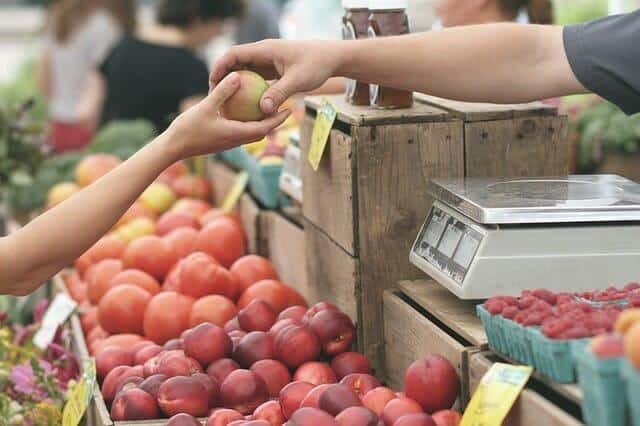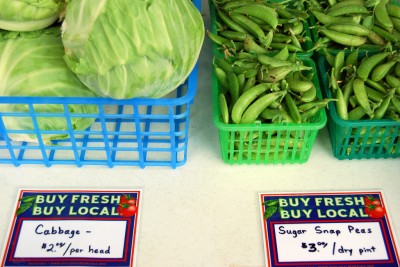|
Listen To The Article
|
Local sourcing for food and other goods is all the buzz nowadays, for a lot of reasons. Many people know about and agree with at least some of the reasons, which include supporting our neighbors, using less water and petroleum for processing and packaging and shipping, getting more personal service, and having a level of trust in the skills and ethics of the producer.
But there is another compelling reason for buying local which we might not always think about: When we buy local, we are paying it forward to our own future.
Consider the possibility of a catastrophic event occurring which could interrupt conventional — that is to say, non-local — food supply lines. That isn’t hard to imagine, and it could include anything from sudden severe weather to a workers’ strike to infrastructure failure to power grid collapse to an oil embargo to war. When considering all the things that could possibly interfere with the global flow of food, it almost seems like more of a question of “when” than “if.”
Short-Term and Long-Term Disasters
It could be short-term — a superstorm taking out a major highway bridge or lightening damage to power lines — or isolated to one or two products, like a fungus that kills coffee plants or a killing freeze in orange groves. Many disasters could reverberate into secondary and tertiary repercussions, such as high oil prices resulting in expensive livestock grain which in turn raises the cost of meat and other animal products.
Longer-term disturbances could occur, as well. A terrorist attack or an electromagnetic pulse (EMP) could destroy a central distribution warehouse, food processing plant, railroad hub or even an entire city.
Other disasters could result in a long-term change in food as we know it. Diseases that make raising a particular breed of hogs or dairy cattle could mean the difference between meat and cheese on the table every day or just for special occasions. The fallout from a volcano or escalating effects of climate change could make certain foods harder or impossible to raise.
Be Prepared. Get The ULTIMATE Food Protection Plan
Whatever does happen, it is likely that our society can and will do whatever it takes to regain equilibrium. It could take days, weeks or even years, but we are survivors. Over the centuries, humanity has learned from the ground up. We have created tools, harnessed horsepower, cultivated the soil, and developed technology, and we can do it all again.
Back to the Future
People in 19th-century America acquired much of what they needed locally or regionally. Along with butchers and bakers and candlestick makers, there were farriers and millers and sawyers. There were midwives and lumbermen and gunsmiths and potters and herbalists. There were manufactories for wagon wheels and oak barrels, woolen mills and commercial carding and weaving machines, grist mills and sawmills. There were makers of cheese and soap and carriages and saddles, as well as repair shops for all kinds of goods.
Whole foods were produced locally, too. Unlike today, where different areas of the continent specialize in certain crops — blueberries and lobsters in the Northeast, wheat in the Great Plains, citrus in the South, and salad vegetables on the West Coast — every region was diversified. They exported less and imported less, and were able to sustain themselves on food raised close to home.
In the event of a disaster, we would likely return to more regional and local sourcing, either as an interim step on the road back to the kind of global commerce we are currently accustomed to or as an end result itself.
Here’s Why Local Matters
But what about in the interim? Buildings and machinery and skills do not pop up overnight. It takes time and money and practice to develop a specialty business.
Are Your Prepared For A Downed Grid? Get Backup Electricity Today!
Imagine that your supply of an important food staple comes from a thousand miles away, and it is suddenly cut off. You would naturally turn to local possibilities instead, but so would all your neighbors. There would be a much greater demand than supply, and that is even if the foods were available at all.
If small-scale regional raw food producers were already up and running, it would greatly enhance the chances for survival and comfort for people around them. But the only way they can be up and running already is if they are supported before disaster strikes. Consider grain production, for example. If people on the coasts lost the ability get it shipped in from Midwestern wheat fields, there would be thousands of farmers from Maine to Arizona scurrying out to plant wheat. But first they have to acquire the seed — which may be challenging if supply lines are down — and then plow, plant, tend, harvest and mill it. The overall result could be very different if some of those farmers had already been growing wheat.
If there are market gardeners and grist mills and cheesemakers and charcuteries and small dairies and people selling backyard maple syrup and eggs from free-range chickens near you, I urge you to buy from them. Even if it costs more. Without the support of customers, they cannot stay in business — meaning that in the event of emergency, instead of being all set up to supply the community’s needs, the would-be local food producers might well end up standing in line and competing for resources with everyone else.
By investing in local producers now, we are all investing in our own future. It is about far more than supporting neighbors and appreciating artisanship and treading lightly on the planet, and could even turn out to be an integral component of our own survival. If we wait until the regional skills and infrastructure are our only choice, it could be too late.
Do you agree? Share your thoughts in the section below:
 Off The Grid News Better Ideas For Off The Grid Living
Off The Grid News Better Ideas For Off The Grid Living





